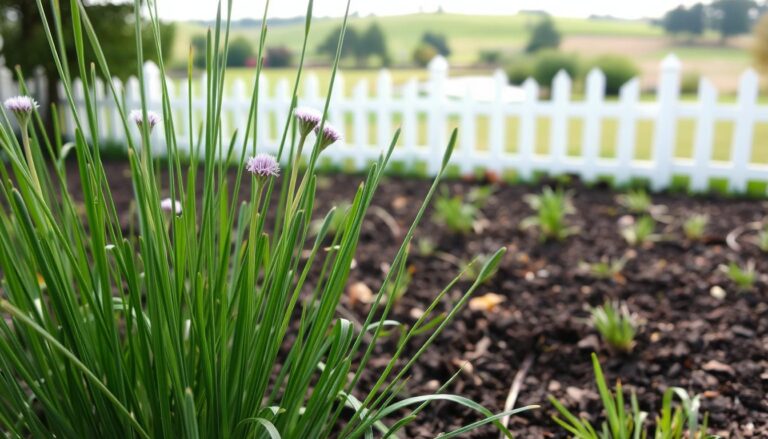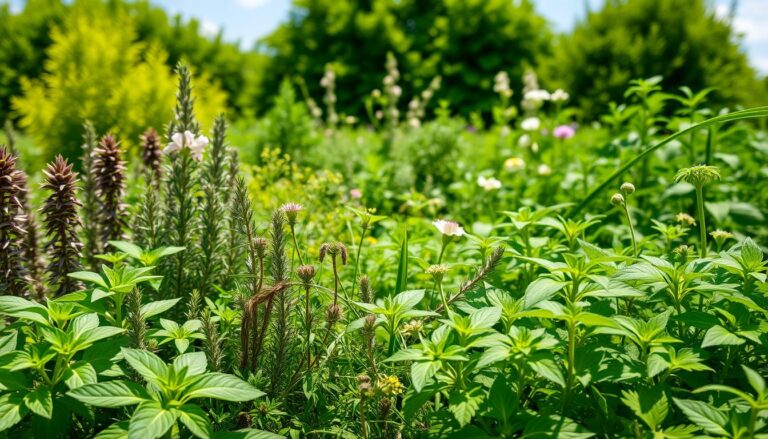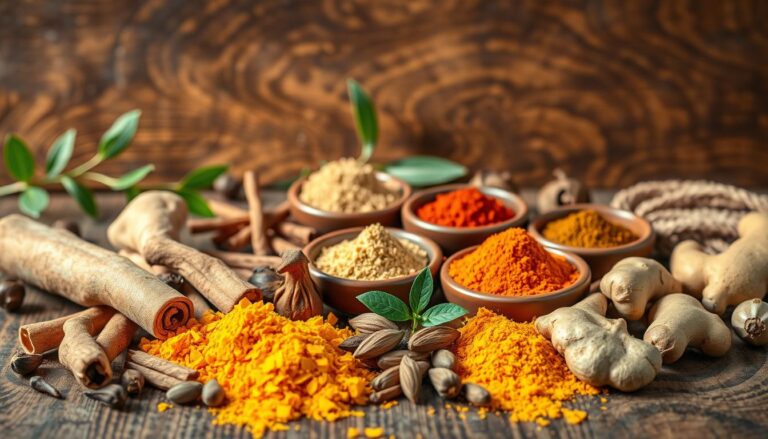Sage Herb Plants Everything You Need to Know
Are you looking to add a versatile and aromatic herb to your garden or indoor space? Do you want to know the secrets to growing a healthy and thriving sage plant?
Sage is a perennial herb from the Mediterranean, loved for cooking and health benefits. It’s hardy and grows well in many conditions. This makes it a great choice for any herb garden or indoor container.

By growing sage indoors, you can enjoy its benefits all year. With the right care, your sage will flourish. It will give you fresh flavor and fragrance.
Key Takeaways
- Understand the basics of sage herb plants and their benefits
- Learn how to grow sage indoors with ease
- Discover the secrets to caring for your sage plants
- Explore the various uses of sage in cooking and beyond
- Find out how to keep your sage plant healthy and thriving
The World of Sage Herb Plants
The world of sage herb plants is vast and varied. It includes culinary, medicinal, and cultural uses. Exploring sage reveals its versatility and many benefits.
Popular Varieties of Culinary Sage
Sage has many varieties, each with its own traits and uses. The most common types include:
Common Garden Sage (Salvia officinalis)
This is the most recognized and used sage. It’s known for its savory flavor and aroma. Common garden sage is a kitchen staple, used in stuffing, roasted meats, and soups.
Specialty Sage Varieties
There are specialty sages like purple, golden, and pineapple sage. These offer different flavors and colors, adding a unique twist to dishes.
| Sage Variety | Flavor Profile | Culinary Use |
|---|---|---|
| Common Garden Sage | Savory, slightly bitter | Stuffing, roasted meats, soups |
| Purple Sage | Slightly peppery, robust | Marinades, sauces, roasted vegetables |
| Golden Sage | Mild, slightly sweet | Salads, dressings, herb butters |
| Pineapple Sage | Fruity, slightly sweet | Desserts, cocktails, fruit salads |
The Rich History and Cultural Significance of Sage
Sage has been valued for centuries, not just for cooking but also for its health benefits. As noted by
“Sage is a herb that has been used for centuries in traditional medicine to treat various ailments, from digestive issues to cognitive function.”
Its cultural importance is seen in its use in rituals and ceremonies worldwide.
You can grow sage with other herbs, making a diverse and strong garden. Good companion plants for sage are rosemary, thyme, and oregano. They share growing conditions and benefit from sage’s pest-repelling qualities.
Essential Growing Conditions for Successful Sage Plants
To grow sage plants well, you need to know about their climate, sunlight, and water needs. Providing the right conditions is key for their success.
Climate and Temperature Requirements
Sage plants do best in a temperate climate with moderate temperatures. They grow best between 60°F and 70°F. Temperatures above 80°F can cause stress, and below 40°F can damage them. Keeping them in this temperature range is vital for their health.
Sunlight Needs for Vibrant Growth
Sage plants need full sun to thrive, requiring at least 6 hours of direct sunlight daily. Adequate sunlight boosts growth and flavor. If indoors, place them near a sunny window or use grow lights.
Water Requirements and Drought Tolerance
Sage is drought-tolerant but does better with enough moisture. Water your sage plants when the top inch of soil is dry. Avoid overwatering to prevent root rot. Mulching helps keep moisture in and cuts down on watering.
By understanding and meeting these essential growing conditions, you can successfully cultivate healthy and flavorful sage plants.
Selecting the Best Soil for Sage Herb Plants
Sage herb plants need the right soil to grow well. The soil’s quality greatly affects their health and how much they produce.
Optimal Soil pH and Composition
Sage prefers soil that drains well and is slightly acidic to neutral. A pH between 6.0 and 7.0 is best. This helps them absorb nutrients better and stay healthy.
Soil Amendment Techniques
Compost or manure can make the soil better. They help with drainage and adjust the pH. This gives your sage plants the nutrients they need.
Drainage Considerations
Good drainage is key to avoid root rot in sage plants. Adding organic matter or using raised beds can help.
| Soil Type | pH Range | Drainage |
|---|---|---|
| Well-draining | 6.0-7.0 | Good |
| Clay | 6.0-7.0 | Poor |
| Sandy | 6.0-7.0 | Excellent |
Choosing the best soil for sage herb and adjusting it for your sage herb plants ensures a healthy garden. This way, your sage will thrive.

Starting Your Sage Garden: Seeds vs. Cuttings
Growing sage can be done in two ways: starting from seeds or using cuttings. Each method has its own benefits and challenges. Knowing these differences is key to a thriving sage garden.
Growing Sage from Seeds: Step-by-Step Guide
To grow sage from seeds, start by sowing them indoors 6-8 weeks before the last frost. Make sure the soil drains well and keep the temperature steady. Here’s a simple guide:
- Sow seeds 1/8 inch deep in seed starting mix.
- Keep the soil moist and provide adequate light.
- Transplant seedlings outdoors after the last frost.
Table: Sage Seed Starting Timeline
| Weeks Before Last Frost | Action |
|---|---|
| 8 weeks | Sow seeds indoors |
| 6 weeks | Maintain moisture and light |
| 0 weeks | Transplant outdoors |
Propagating Sage Cuttings Successfully
Propagating sage from cuttings is another effective method. Take cuttings in early summer from healthy, vigorous plants. Here’s how:
- Cut 3-4 inch stem sections from the parent plant.
- Remove lower leaves and plant in well-draining soil.
- Keep the soil moist until roots develop.
Growing Sage Indoors: Complete Guide
You can grow sage indoors with the right care. Sage is a versatile herb that does well indoors.
Container Selection and Positioning
For growing sage indoors, pick a container that’s 6-8 inches deep. This size fits the sage’s roots well. Make sure it has holes for drainage to avoid soggy soil. Place the container in a spot with bright, indirect light.

Light and Temperature Management
Sage likes bright, indirect light and temperatures between 65°F and 75°F (18°C to 24°C). Keep it away from heating vents, fireplaces, and drafty windows.
Watering and Fertilizing Indoor Sage Plants
Water your indoor sage when the top inch of soil is dry. Watch out for too much water, which can cause root rot.
Signs of Overwatering and Underwatering
Too much water turns leaves yellow and makes stems soft. Not enough water makes leaves dry and crispy. Adjust your watering based on these signs.
Fertilizer Recommendations
Use a balanced, water-soluble fertilizer in spring and summer. But, dilute it to half strength to protect the roots.
By following these tips, you can care for sage plants indoors. Enjoy fresh sage all year round.
Seasonal Care Guide for Sage Herb Plants
Caring for sage herb plants means adjusting to the seasons. Each season brings different needs for your sage plants. Knowing these needs is key to their health and growth.
Spring and Summer Maintenance Tasks
In spring and summer, your sage plants need regular care. Pruning is a must. Prune in spring for new growth and in summer to keep them bushy.
Here’s a simple table outlining spring and summer tasks:
| Task | Spring | Summer |
|---|---|---|
| Pruning | Prune to encourage new growth | Prune to maintain shape |
| Fertilizing | Apply a balanced fertilizer | Continue with a balanced fertilizer |
| Watering | Water regularly | Water regularly, avoid overwatering |
Fall and Winter Protection Strategies
As fall comes, prepare your sage plants for cold weather. Protect them from frost and cold winds.
Preparing Sage for Cold Weather
Before the first frost, mulch around the base of your sage plants. This protects their roots from freezing. You can also cover them with a frost cloth to shield from harsh winds and frost.
Overwintering Potted Sage Plants
 This could be a greenhouse, sunroom, or indoors by a sunny window. Water less in winter since they grow slower.
This could be a greenhouse, sunroom, or indoors by a sunny window. Water less in winter since they grow slower.
By following these seasonal care tips, your sage herb plants will stay healthy and flourish all year.
Pruning Sage Bushes for Optimal Health and Yield
Regular pruning is key for sage bushes. It encourages new growth, prevents legginess, and boosts herb yield. Pruning is not just about shape; it’s vital for health and productivity.
When and How to Prune Effectively
Prune sage in early spring for new growth and to prevent legginess. Remove dead or damaged branches and cut back one-third of the plant’s height. This promotes bushy growth and prevents early flowering.
Always use clean, sharp tools to prevent disease spread. Make cuts just above a leaf node to encourage new growth.
| Pruning Task | Timing | Benefit |
|---|---|---|
| Remove dead or damaged branches | Early Spring | Prevents disease spread |
| Cut back plant height | Early Spring | Encourages bushy growth |
Rejuvenating Older Sage Plants
Older sage plants can become woody and less productive. Rejuvenation pruning cuts back the plant by half to two-thirds. This stimulates new growth from the base, revitalizing the plant.
After rejuvenation pruning, ensure your sage plant gets enough sunlight, water, and nutrients. This supports new growth.

Harvesting and Preserving Sage Leaves
To enjoy your sage herb plants all year, learn how to harvest and preserve their leaves. Sage is great for cooking and health, and the right methods keep it fresh. This way, you always have some on hand.
Best Times to Harvest for Maximum Flavor
Harvest sage leaves in the morning, after the dew but before it gets hot. This is when they taste and smell the best. You can pick them any time they’re growing, but they’re most flavorful just before they bloom.
Proper Harvesting Techniques
When you harvest sage, do it carefully to not hurt the plant. Pinch or cut off leaves or stems as needed. But don’t take more than a third of the plant’s leaves at once. This helps the plant keep growing.
Methods for Drying and Storing Sage
There are ways to dry and store sage to keep its taste and smell. You can air dry or freeze it.
Air Drying Sage Leaves
A simple way to dry sage is to tie stems in small bunches. Hang them upside down in a warm, dry, dark spot. Once they’re dry, take off the leaves and put them in airtight containers.
Freezing Sage for Long-Term Storage
Freezing is another good way to keep sage fresh. You can freeze leaves whole, chopped, or mixed with oil in ice cube trays. Frozen sage is great for cooking, as it keeps its flavor and smell.
| Preservation Method | Description | Best Use |
|---|---|---|
| Air Drying | Tie stems in bunches and hang upside down in a warm, dry place. | Dried sage leaves, teas, and potpourri. |
| Freezing | Freeze whole, chopped, or with oil in ice cube trays. | Cooked dishes, soups, and stews. |
Common Sage Plant Diseases and Pest Management
Diseases and pests can trouble sage plant growers. But, there are ways to fight them. Knowing these problems helps keep your plants healthy.
Identifying Disease Symptoms and Causes
Sage plants face diseases like powdery mildew and root rot. Powdery mildew shows as a white powder on leaves, caused by damp air and poor air flow. Root rot comes from too much water, making roots soft and rotting.
Natural and Organic Treatment Options
To fight powdery mildew, try baking soda or neem oil. For root rot, better drainage and less water help. Aphids and spider mites can be controlled with insecticidal soap or neem oil.
These organic methods keep your sage plants healthy without harsh chemicals.
Preventative Measures for Healthy Plants
Keeping diseases and pests away is key for healthy sage plants. Make sure plants have good air flow, don’t overwater, and keep the area clean. Regular pruning also helps by encouraging healthy growth.
| Disease/Pest | Symptoms | Prevention/Treatment |
|---|---|---|
| Powdery Mildew | White powdery substance on leaves | Baking soda solution, neem oil, improve air circulation |
| Root Rot | Soft, rotting roots | Improve drainage, reduce watering |
| Aphids | Small, sap-sucking insects | Insecticidal soap, neem oil |
Beneficial Companion Plants for Sage in Your Garden
The right companion plants for sage can make your sage herb plants grow better. By picking the right friends for your garden, you can make it a balanced and lively place.
Plants That Thrive Alongside Sage
Some plants go great with sage herb plants, like carrots, tomatoes, and rosemary. These plants live well together and help each other grow strong and fight off pests.
- Carrots: Sage keeps away pests that bother carrots, like carrot flies.
- Tomatoes: Sage makes tomatoes taste better and keeps pests away.
- Rosemary: Sage and rosemary both like dry soil and need similar care.
Plants to Avoid Growing Near Sage
But, not all plants are good friends with sage. For example, cucumbers and onions don’t get along with sage.
Compatibility Issues with Other Herbs
Some herbs don’t mix well with sage. This is because they need different things to grow or might get the same pests.
Space and Resource Competition
Think about how much space and resources each plant needs. Plants that fight for water and food with sage can harm its health. So, choose wisely to keep your sage herb plants happy and healthy.
Culinary and Medicinal Applications of Sage
Sage is a herb known for its savory flavor and healing properties. It has been used for centuries in cooking and medicine. You can use sage in many ways, like fresh leaves, dried herbs, or even as essential oil.
Cooking with Fresh and Dried Sage Leaves
Cooking with sage can make your dishes taste better. Fresh sage leaves are great in salads or as a garnish. Dried sage is often used in stuffing, sauces, and soups. Some popular culinary uses include:
- Adding fresh sage to roasted meats or vegetables
- Using dried sage in traditional dishes like stuffing or sausages
- Incorporating sage into soups and stews for added depth
Traditional and Modern Medicinal Uses
Sage has been used for its medicinal properties for a long time. It has antioxidant and anti-inflammatory effects. Using sage can help with health issues. Some of its medicinal uses include:
- Relieving digestive issues
- Easing symptoms of menopause
- Improving cognitive function
“Sage has been used in traditional medicine for its ability to improve memory and cognitive function.”
Conclusion: Enjoying the Rewards of Your Sage Garden
Sage herb plants can add a lot to your garden. They give you fresh leaves for cooking and make your garden look good. By following the tips in this article, you can grow and care for your sage plants well.
It’s important to know how to care for sage plants. Regular pruning, harvesting, and fertilizing will keep them healthy. Using sage in your cooking and herbal remedies will show you how valuable it is.
Whether you’re new to gardening or have been doing it for a while, growing sage is fun. By using what you learned here, you can enjoy the benefits of sage plants. Your garden will look better and be more useful.
FAQ
What are the ideal conditions for growing sage herb plants?
Sage plants do best in well-drained soil with a pH of 6.0 to 7.0. They need full sun and moderate watering. They can handle some drought but prefer regular water.
How often should I prune my sage bushes?
Prune your sage in the spring for new growth and after it flowers to keep it shaped. Regular pruning stops it from getting too long.
Can I grow sage indoors, and if so, how?
Yes, you can grow sage indoors in a container with good drainage. Place it in a sunny spot. Be careful with light, temperature, and water to help it thrive.
What are the best methods for harvesting sage leaves?
Harvest sage leaves in the morning, after dew has gone but before it gets hot. Pinch or cut off the leaves carefully to avoid damaging the stems.
How do I propagate sage cuttings?
Take cuttings from healthy sage plants, remove lower leaves, and plant them in well-drained soil. Keep the soil moist until roots grow, usually in a few weeks.
What are common diseases that affect sage plants, and how can I treat them?
Sage can get root rot, powdery mildew, and spider mites. Use natural remedies like neem oil to treat these. Also, make sure there’s good air circulation and proper watering.
Can sage be grown alongside other herbs, and which ones?
Sage grows well with herbs like rosemary, thyme, and oregano. They all need similar conditions. But avoid planting sage near herbs that need more moisture, like mint or basil.
How do I preserve sage for later use?
Dry sage by tying it in bunches and hanging it upside down, or freeze it in ice cube trays with olive oil or water. Dried sage can last a year or more if stored properly.
What are the culinary uses of sage?
Sage is great in stuffing, roasted meats, soups, and stews. It goes well with pork, beans, and certain cheeses.
Are there any medicinal benefits to using sage?
Sage has been used for its health benefits, like improving memory and digestion. But talk to a healthcare professional before using it for health reasons.







